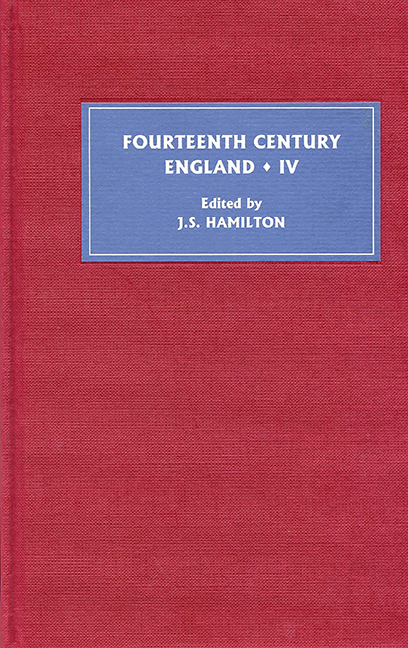Book contents
- Frontmatter
- Contents
- List of Illustrations
- Contributors
- Preface
- Abbreviations
- Who was St Thomas of Lancaster? New Manuscript Evidence
- ‘Hedging, Ditching and Other Improper Occupations’: Royal Landscapes and their Meaning under Edward II and Edward III
- Paying for the Wedding: Edward III as Fundraiser, 1332–3
- The Politics of Privilege: Thomas Hatfield and the Palatinate of Durham, 1345–81
- Agnes Maltravers (d. 1375) and her Husband John (d. 1364): Rebel Wives, Separate Lives, and Conjugal Visits in Later Medieval England
- Gendering Pastoral Care: John Mirk and his Instructions for Parish Priests
- Prosecution of the Statutes of Provisors and Premunire in the King's Bench, 1377–1394
- ‘Mercy and Truth Preserve the King’: Richard II's Use of the Royal Pardon in 1397 and 1398
- Aliens in the Pardons of Richard II
- ‘Too Flattering Sweet to be Substantial’? The Last Months of Thomas, Lord Despenser
- ‘O Prince, Desyre to be Honourable’: The Deposition of Richard II and Mirrors for Princes
- Regional Politics, Landed Society and the Coal Industry in North-East England, 1350–1430
‘Too Flattering Sweet to be Substantial’? The Last Months of Thomas, Lord Despenser
Published online by Cambridge University Press: 12 September 2017
- Frontmatter
- Contents
- List of Illustrations
- Contributors
- Preface
- Abbreviations
- Who was St Thomas of Lancaster? New Manuscript Evidence
- ‘Hedging, Ditching and Other Improper Occupations’: Royal Landscapes and their Meaning under Edward II and Edward III
- Paying for the Wedding: Edward III as Fundraiser, 1332–3
- The Politics of Privilege: Thomas Hatfield and the Palatinate of Durham, 1345–81
- Agnes Maltravers (d. 1375) and her Husband John (d. 1364): Rebel Wives, Separate Lives, and Conjugal Visits in Later Medieval England
- Gendering Pastoral Care: John Mirk and his Instructions for Parish Priests
- Prosecution of the Statutes of Provisors and Premunire in the King's Bench, 1377–1394
- ‘Mercy and Truth Preserve the King’: Richard II's Use of the Royal Pardon in 1397 and 1398
- Aliens in the Pardons of Richard II
- ‘Too Flattering Sweet to be Substantial’? The Last Months of Thomas, Lord Despenser
- ‘O Prince, Desyre to be Honourable’: The Deposition of Richard II and Mirrors for Princes
- Regional Politics, Landed Society and the Coal Industry in North-East England, 1350–1430
Summary
‘Murder, like talent, seems occasionally to run in families.’ The nineteenth-century British philosopher George Henry Lewes could almost have been writing of the Despenser family, for whom being murdered – or, at least, failing to die warm in their beds – was an alarming family tendency. In six generations, no fewer than three of the Despensers were executed brutally, another was slaughtered at the battle of Evesham (1265), and the remaining two are believed to have fallen victim to plague. Of these six generations, easily the most politically significant deaths were those of Hugh Despenser the younger, who was hanged, drawn and quartered at Hereford in 1326, and Thomas Despenser, murdered by a mob in Bristol market place in January 1400.
Despite taking place more than seventy years apart, the deaths were inextricably linked to the downfalls of Edward II and Richard II respectively. Contemporaries, of course, recognised connections between the two reigns, and Richard II himself drew attention to such comparisons through his unsuccessful attempts to secure his great-grandfather's canonisation, in support of which he adorned the columns of Edward II's Gloucester tomb with white harts, a potent symbol of Ricardian kingship. However, of most importance to the argument presented here is the way in which both kings drew around them a tight-knit group of men of dubious merit: in Edward II's case, Hugh Despenser the younger and his cronies; in Richard II's, his duketti, which included Thomas Despenser. The involvement of members of the same family on both occasions is striking, but whilst the last months of the younger Hugh have been charted in some detail, those of his descendant have not. It is the intention of this article to follow the movements of Thomas Despenser in his last eight months (May 1399 to January 1400), using several hitherto-overlooked documents in The National Archives to shed further light on his activities. This should further clarify the role of a man whom the duke of Norfolk described as ‘the last and the least of the [Epiphany] conspirators’, yet who was a rising star of the court and whose attitudes and actions may also provide insight into the king's own behaviour at this time.
- Type
- Chapter
- Information
- Fourteenth Century England IV , pp. 146 - 158Publisher: Boydell & BrewerPrint publication year: 2006

